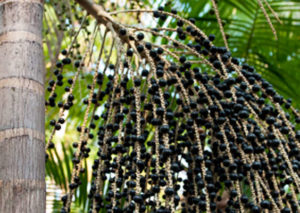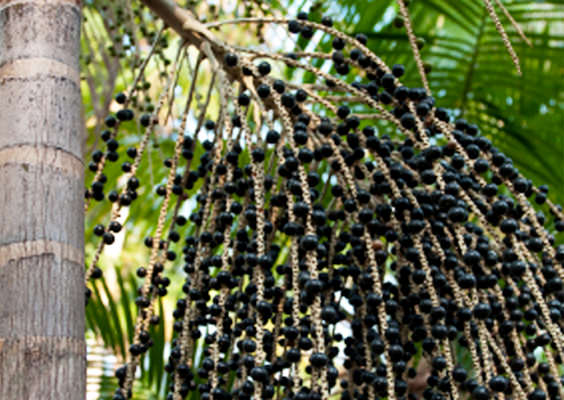
During one of my trips to Brazil a few years ago, I went in search of new healing herbs I could use at my wellness center. That’s when I discovered açaí berries.
Now everyone’s talking about these berries. And they really are one of the richest sources in antioxidants, vitamins A, B, C, and E, minerals and omega-3s.
In fact, I ended up including powdered açaí berries in one of my supplements.
Back then, they were pretty much a novelty outside of South America, but now I even see frozen açaí berry smoothie packs when I’m in the grocery store.
And that’s my problem with açaí berries – they grow mostly in the Amazon floodplains, but here in America you can’t get them fresh.
Of course, like most fruit and vegetables, freezing them only slightly reduces the nutritional content of the berries. But the process inevitably changes their flavor and texture.
And for the best nutritional value and “kick,” it’s impossible to beat any fresh fruit that’s eaten straight from the tree or vine.
The locals in the Amazon always eat açaí berries fresh. Then, after a day or so, they just throw them out.
I remember eating fresh açaí berries with some of the tribes-people in the Amazon and I felt a noticeable boost – both mentally and physically.
These super-berries can enhance your brainpower, something those Big Pharma chemical creations have so far failed to do.
The secret is a group of biochemicals called anthocyanins. They give fruit and vegetables a range of colors from red to blue and purple. But they do a lot more.
In one study, anthocyanin extract helped reduce brain-cell damage from Parkinson’s disease.1
They work by firing up mitochondria, the tiny biological power plants that provide energy to cells. The extra energy helped the brain cells resist
the neurotoxins linked to the disease.Anthocyanins are also potent antioxidants that help keep your brain young by reducing inflammation and by helping remove and break down toxic biochemical byproducts that damage neurons.2,3,4,5
Researchers have shown that this plant dye can do what no prescription drug can do – promote the creation of brain-derived neurotrophic factor, or BDNF.6
BDNF is one of the hallmarks of a young, vital brain and nervous system.
Your brain can’t grow new nerve connections if it doesn’t have enough BDNF. And the more you have, the more easily your brain creates connections among your neurons.
And a shortage of BDNF makes it harder for your brain to move memories from short-term to long-term storage.
Açaí berries are just one of my favorite sources of anthocyanins. If you get them fresh, the power of anthocyanins extends to many other fruits and vegetables. Here are just a few:
- Blackberries;
- Blueberries;
- Cranberries;
- Eggplant;
- Grapes;
- Cherries;
- Plums;
- Red beets;
- Red cabbage;
- Strawberries.
And as a fan of fresh fruit and vegetables, here’s a fresh drink I like to make myself. It’s loaded with key nutrients, vital cellulose and, of course, anthocyanins.
I call it simply my “purple drink.” I gather red beet, or other anthocyanin-rich vegetables, along with an occasional fruit. Then I blend them with ice into a large smoothie.
Here’s one of my favorite recipes:
- 1 whole lime, peeled
- 1 whole beet
- 1 whole cucumber
- ¼ cup of cilantro
- 1/16th piece of turmeric
- ¼ cup of coconut water
- 1 cup of filtered tap water
- ¼ cup of kale
- ¼ cup of spinach
- ¼ cup of arugula
- 6 stalks of dandelion greens
- 4 baby carrots
- ½ cup of ice
You don’t have to follow this recipe to the letter. You can make it to your taste.
But remember, you don’t want to spike your blood sugar, which will end up stored as fat. So choose ingredients that will keep the mix low on the glycemic index. And here’s a link to my glycemic guide that you can use to help.
To your good health,
![]()
Al Sears, MD, CNS
1. Strathearn, K.E., et al. “Neuroprotective effects of anthocyanin- and proanthocyanidin-rich extracts in cellular models of Parkinson’s disease.” Brain Research.Vol. 1555, 25 March 2014, Pages 60–77.
2. Poulose, S., et al. “Anthocyanin-rich acai (Euterpe oleracea Mart.) fruit pulp fractions attenuate inflammatory stress signaling in mouse brain BV-2 microglial cells.” J. Agric Food Chem. 2012 Feb 1;60(4):1084-93. doi: 10.1021/jf203989k. Epub 2012 Jan 20.
3. Poulose, S., et al. “Improving brain signaling in aging: Could berries be the answer?” Expert Review of Neurotherapeutics. August 2012, Vol. 12, No. 8 , Pages 887-889 (doi:10.1586/ern.12.86).
4. Lee, S.G., et al. “Berry anthocyanins suppress the expression and secretion of proinflammatory mediators in macrophages by inhibiting nuclear translocation of NF-kB independent of NRF2-mediated mechanism.” The Journal of Nutritional Biochemistry. Published online Jan. 2, 2014.
5. American Chemical Society. “Eating berries may activate the brain’s natural housekeeper for healthy aging. ScienceDaily. August 24, 2010.
<www.sciencedaily.com/releases/2010/08/100823142927.htm>
6. Rendeiro, C., et al. “Dietary levels of pure flavonoids improve spatial memory performance and increase hippocampal brain-derived neurotrophic factor.” PLOS One. 2013 May 28:8(5).

